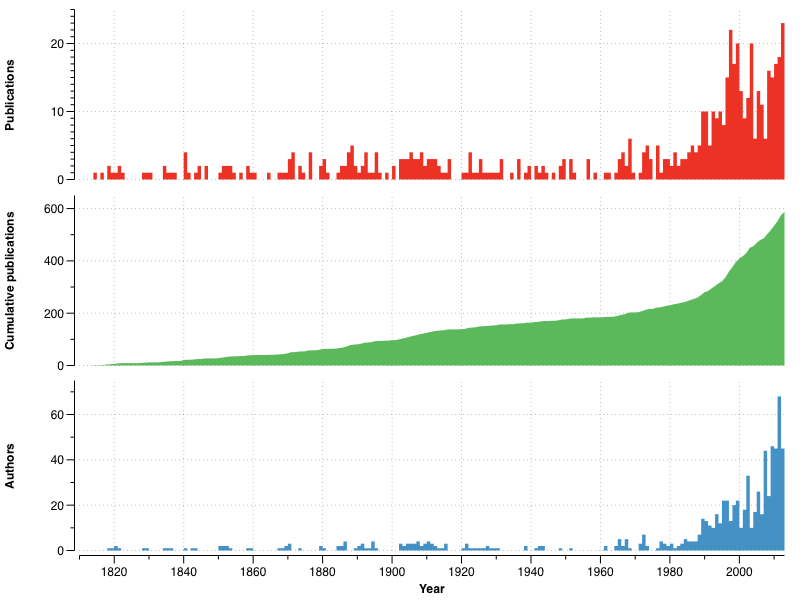Is there really an ichthyosaur renaissance going on?
The phrase ‘ichthyosaur renaissance’ was one that I first heard at the Symposium of Vertebrate Palaeontology and Comparative Anatomy in Lyme Regis, 2011. This came from Darren Naish’s talk on Robert Appleby’s ichthyosaur work – part of which, on an odd Cretaceous ichthyosaur from Iraq, has recently been published (Fischer et al. 2013) and written about on Darren’s blog Tetrapod Zoology – and I’ve used it many times since. So what does it actually mean?

Many of the large fossil vertebrate groups – ichthyosaurs, plesiosaurs and dinosaurs among them – have had long histories and many ups and downs. They were first properly recognised and published upon 199, 192 and 189 years ago respectively (Home 1814; De la Beche and Conybeare 1821; Buckland 1824) and immediately captured both geologists’ and the public’s hearts. From this, there was much study, so that by the end of the 19^th^ Century the groups were considered ‘complete’ and any new finds would be easily fitted in. All three have a noticeable scarcity of publications between the 1920s through 1960s–70s, especially compared to the large monographs the late 1800s (e.g. Owen 1881).
However, what has happened in the last 30–40 years is that interest has returned to the ichthyosaurs, plesiosaurs and dinosaurs. In ichthyosaurs, where this started can be fairly precisely pinpointed to the period 1965–1975 and the work of Appleby, Mazin, Romer and McGowan in particular. Since then, there has been a sharp rise in the numbers of publications and authors, such that publications on ichthyosaurs are approaching, or may have passed, 600 in total – two-thirds of which were published within the past 45–50 years. Of course, these are only the ones that I known of, and that certainly is not all.
So in answer to the titular question: yes, there is really an ichthyosaur renaissance.
References
BUCKLAND, W. 1824. Notice on the Megalosaurus or great fossil lizard of Stonesfield. Transactions of the Geological Society of London, Second Series, 1, 390–396. doi:10.1144/transgslb.1.2.390
DE LA BECHE, H. T. and CONYBEARE, W. D. 1821. Notice of the discovery of a new fossil animal, forming a link between the Ichthyosaurus and crocodile, together with general remarks on the osteology of the Ichthyosaurus. Transactions of the Geological Society of London, s1-5, 559–594. doi:10.1144/transgsla.5.559
FISCHER, V., APPLEBY, R. M., NAISH, D., LISTON, J., RIDING, J. B., BRINDLEY, S. and GODEFROIT, P. 2013. A basal thunnosaurian from Iraq reveals disparate phylogenetic origins for Cretaceous ichthyosaurs. Biology Letters, 9, 20130021. doi:10.1073/pnas.1018959108
HOME, E. 1814. Some account of the fossil remains of an animal more nearly allied to fishes than any of the other classes of animals. Philosophical Transactions of the Royal Society of London, 104, 571–577. doi:10.1098/rstl.1814.0029
OWEN, R. 1881. A monograph of the fossil Reptilia of the Liassic Formations. Part III. Plesiosaurus, Dimorphodon, and Ichthyosaurus. Monograph of the Palaeontographical Society, 17, 23, 35, 1–134, pls. 1–33.

Leave a comment